Strategies for Boosting Innovation and Productivity in Organizations
VerifiedAdded on 2021/05/27
|10
|2335
|60
Report
AI Summary
This report analyzes the significance of creative leadership and human resource management in fostering innovation and improving organizational productivity. It explores the impact of creativity on business development, highlighting how factors like leadership styles, organizational culture, and structure either stimulate or hinder innovation. The report emphasizes the importance of human resource practices such as planning, profit sharing, staff selection, and training, as well as the value of teamwork in generating new ideas. It discusses barriers to innovation, including leadership attitudes, societal perceptions, and organizational rules, and proposes strategies for overcoming them, such as promoting a no-ridicule environment and encouraging risk-taking. Additionally, the report addresses the role of change management in fostering creativity and innovation, with recommendations for implementation. The report concludes by emphasizing the benefits of a creative workforce, including increased profits and market competitiveness, and suggests ways for organizations to promote and sustain innovation, such as rewarding employees for new ideas and providing necessary resources.

1
Presented by
Affiliation
Supervisor
Date of Submission
Presented by
Affiliation
Supervisor
Date of Submission
Paraphrase This Document
Need a fresh take? Get an instant paraphrase of this document with our AI Paraphraser
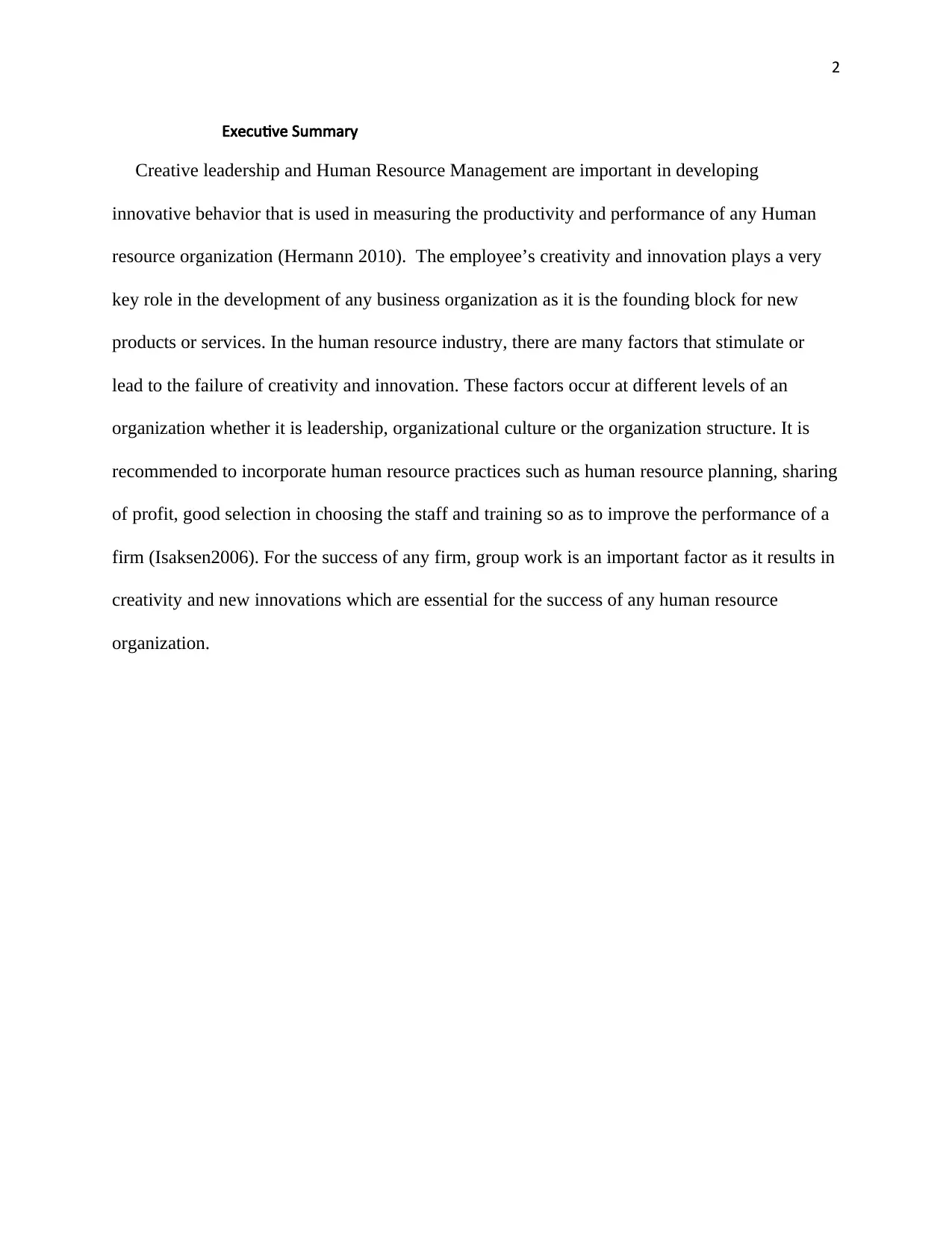
2
Executive Summary
Creative leadership and Human Resource Management are important in developing
innovative behavior that is used in measuring the productivity and performance of any Human
resource organization (Hermann 2010). The employee’s creativity and innovation plays a very
key role in the development of any business organization as it is the founding block for new
products or services. In the human resource industry, there are many factors that stimulate or
lead to the failure of creativity and innovation. These factors occur at different levels of an
organization whether it is leadership, organizational culture or the organization structure. It is
recommended to incorporate human resource practices such as human resource planning, sharing
of profit, good selection in choosing the staff and training so as to improve the performance of a
firm (Isaksen2006). For the success of any firm, group work is an important factor as it results in
creativity and new innovations which are essential for the success of any human resource
organization.
Executive Summary
Creative leadership and Human Resource Management are important in developing
innovative behavior that is used in measuring the productivity and performance of any Human
resource organization (Hermann 2010). The employee’s creativity and innovation plays a very
key role in the development of any business organization as it is the founding block for new
products or services. In the human resource industry, there are many factors that stimulate or
lead to the failure of creativity and innovation. These factors occur at different levels of an
organization whether it is leadership, organizational culture or the organization structure. It is
recommended to incorporate human resource practices such as human resource planning, sharing
of profit, good selection in choosing the staff and training so as to improve the performance of a
firm (Isaksen2006). For the success of any firm, group work is an important factor as it results in
creativity and new innovations which are essential for the success of any human resource
organization.
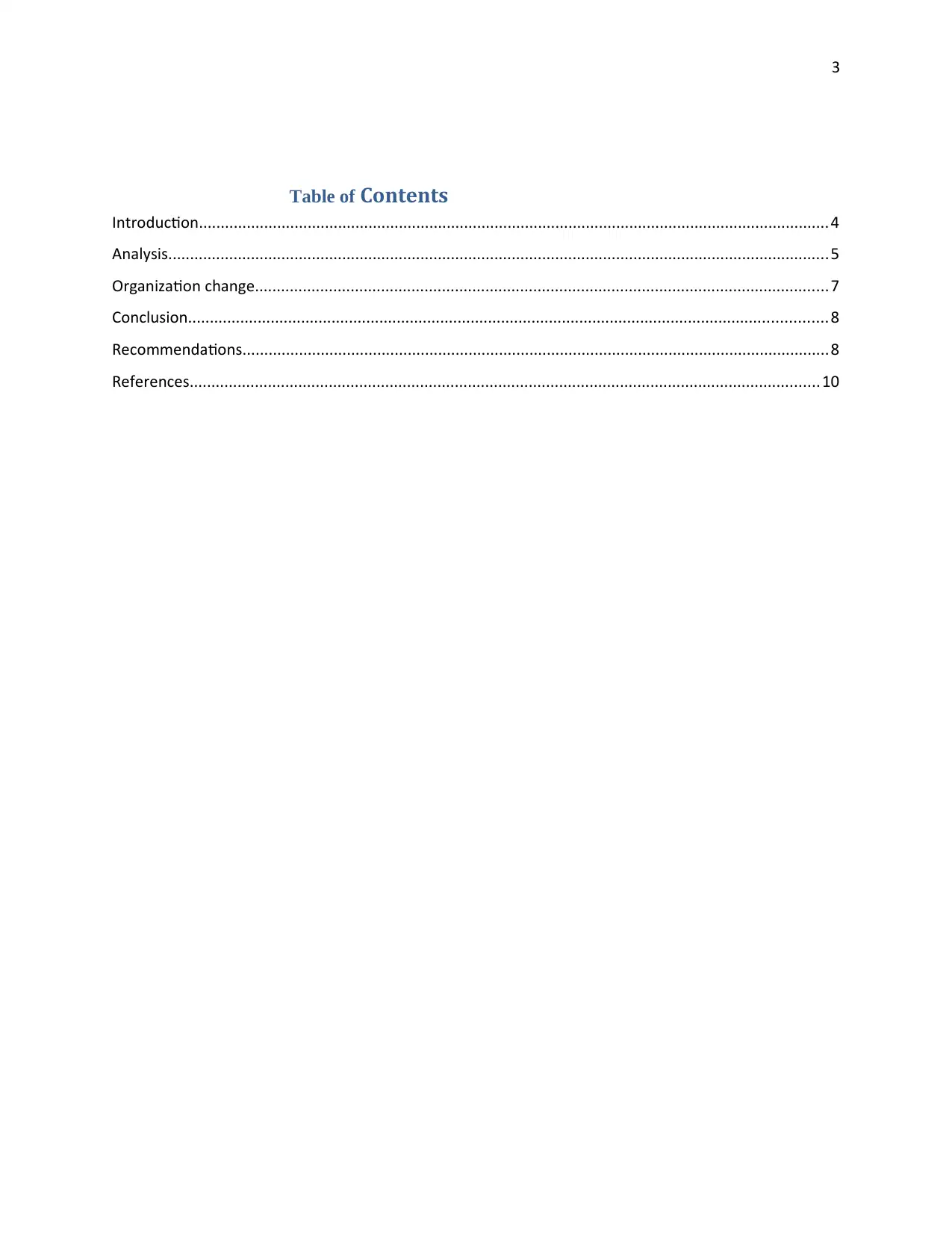
3
Table of Contents
Introduction.................................................................................................................................................4
Analysis........................................................................................................................................................5
Organization change....................................................................................................................................7
Conclusion...................................................................................................................................................8
Recommendations.......................................................................................................................................8
References.................................................................................................................................................10
Table of Contents
Introduction.................................................................................................................................................4
Analysis........................................................................................................................................................5
Organization change....................................................................................................................................7
Conclusion...................................................................................................................................................8
Recommendations.......................................................................................................................................8
References.................................................................................................................................................10
⊘ This is a preview!⊘
Do you want full access?
Subscribe today to unlock all pages.

Trusted by 1+ million students worldwide
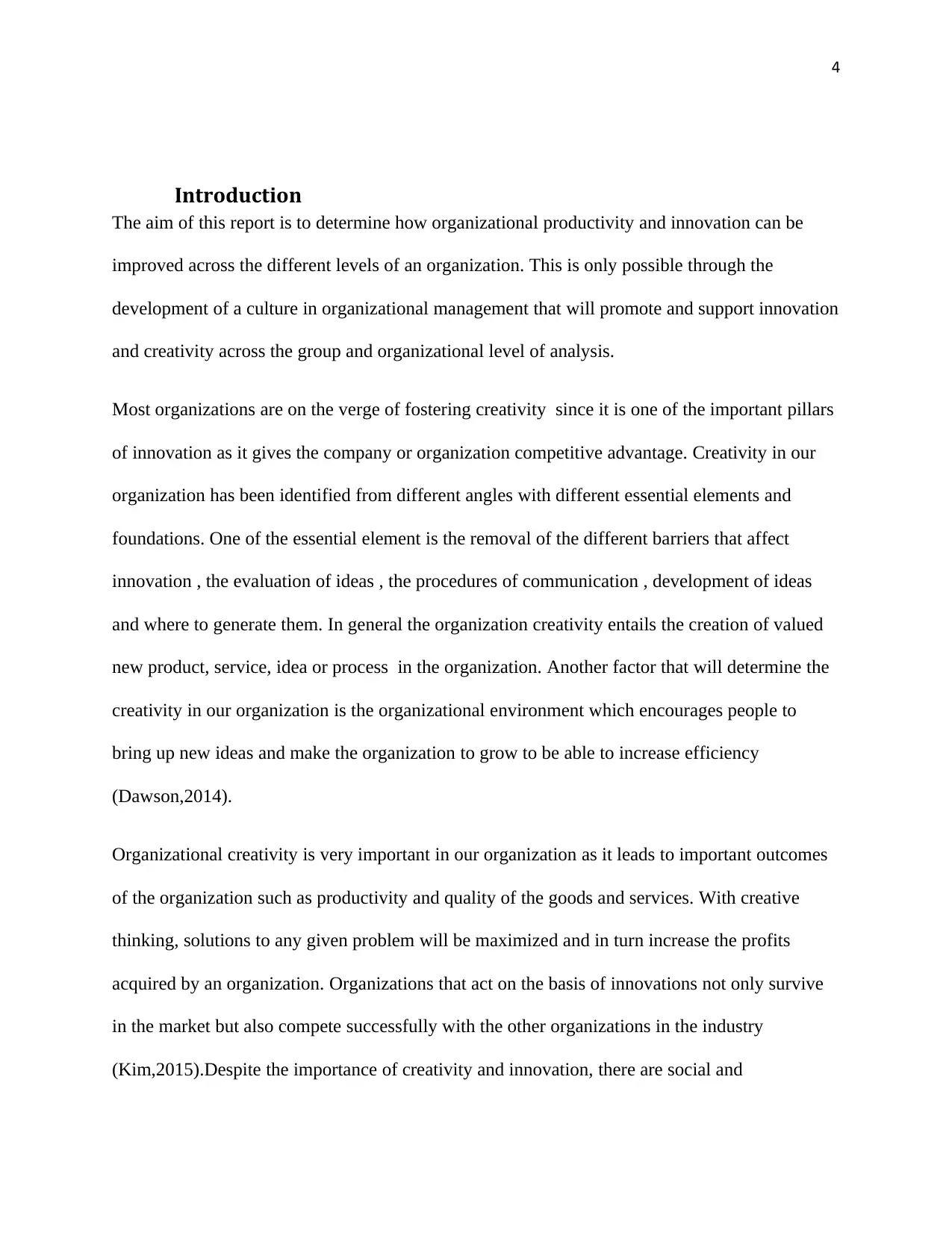
4
Introduction
The aim of this report is to determine how organizational productivity and innovation can be
improved across the different levels of an organization. This is only possible through the
development of a culture in organizational management that will promote and support innovation
and creativity across the group and organizational level of analysis.
Most organizations are on the verge of fostering creativity since it is one of the important pillars
of innovation as it gives the company or organization competitive advantage. Creativity in our
organization has been identified from different angles with different essential elements and
foundations. One of the essential element is the removal of the different barriers that affect
innovation , the evaluation of ideas , the procedures of communication , development of ideas
and where to generate them. In general the organization creativity entails the creation of valued
new product, service, idea or process in the organization. Another factor that will determine the
creativity in our organization is the organizational environment which encourages people to
bring up new ideas and make the organization to grow to be able to increase efficiency
(Dawson,2014).
Organizational creativity is very important in our organization as it leads to important outcomes
of the organization such as productivity and quality of the goods and services. With creative
thinking, solutions to any given problem will be maximized and in turn increase the profits
acquired by an organization. Organizations that act on the basis of innovations not only survive
in the market but also compete successfully with the other organizations in the industry
(Kim,2015).Despite the importance of creativity and innovation, there are social and
Introduction
The aim of this report is to determine how organizational productivity and innovation can be
improved across the different levels of an organization. This is only possible through the
development of a culture in organizational management that will promote and support innovation
and creativity across the group and organizational level of analysis.
Most organizations are on the verge of fostering creativity since it is one of the important pillars
of innovation as it gives the company or organization competitive advantage. Creativity in our
organization has been identified from different angles with different essential elements and
foundations. One of the essential element is the removal of the different barriers that affect
innovation , the evaluation of ideas , the procedures of communication , development of ideas
and where to generate them. In general the organization creativity entails the creation of valued
new product, service, idea or process in the organization. Another factor that will determine the
creativity in our organization is the organizational environment which encourages people to
bring up new ideas and make the organization to grow to be able to increase efficiency
(Dawson,2014).
Organizational creativity is very important in our organization as it leads to important outcomes
of the organization such as productivity and quality of the goods and services. With creative
thinking, solutions to any given problem will be maximized and in turn increase the profits
acquired by an organization. Organizations that act on the basis of innovations not only survive
in the market but also compete successfully with the other organizations in the industry
(Kim,2015).Despite the importance of creativity and innovation, there are social and
Paraphrase This Document
Need a fresh take? Get an instant paraphrase of this document with our AI Paraphraser
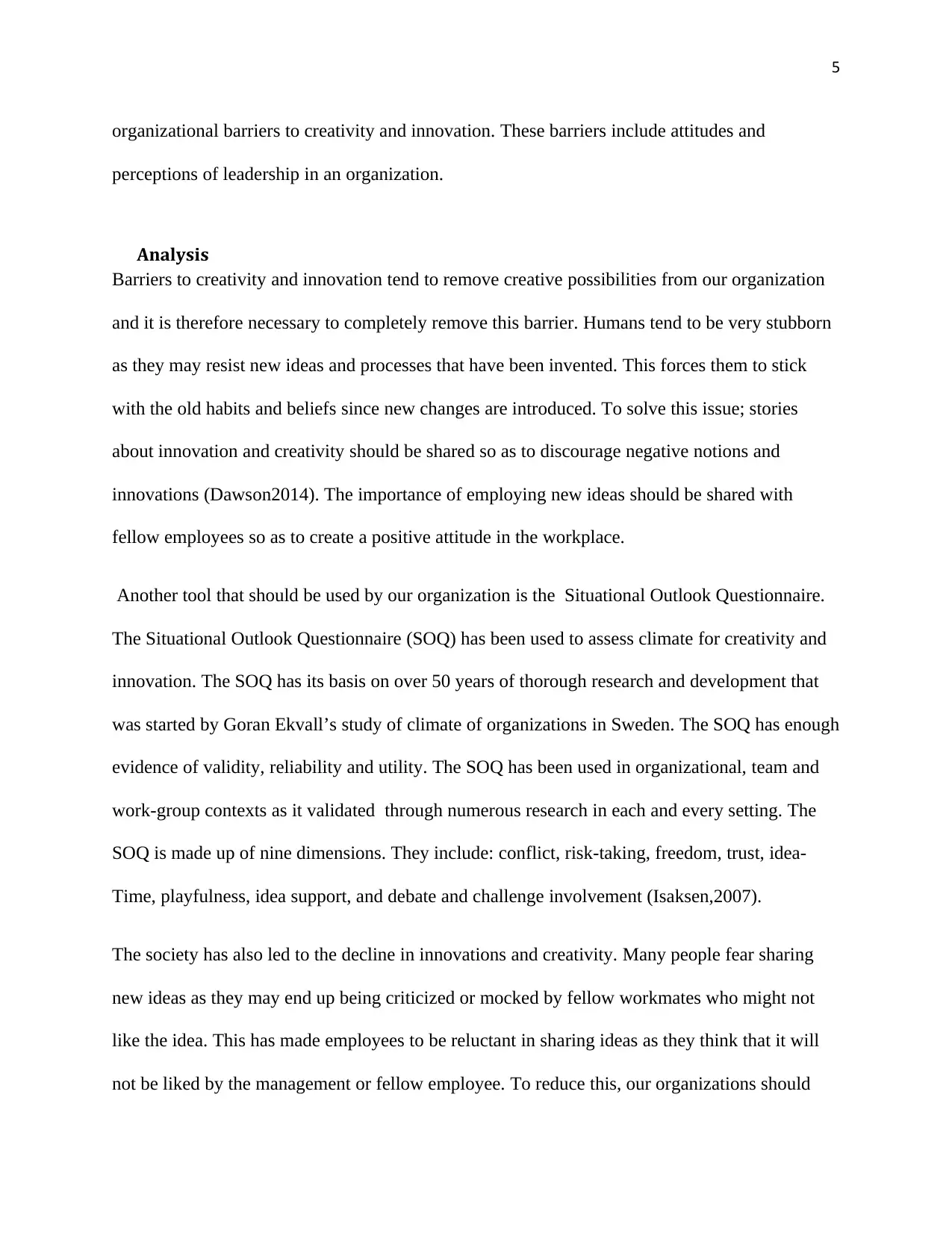
5
organizational barriers to creativity and innovation. These barriers include attitudes and
perceptions of leadership in an organization.
Analysis
Barriers to creativity and innovation tend to remove creative possibilities from our organization
and it is therefore necessary to completely remove this barrier. Humans tend to be very stubborn
as they may resist new ideas and processes that have been invented. This forces them to stick
with the old habits and beliefs since new changes are introduced. To solve this issue; stories
about innovation and creativity should be shared so as to discourage negative notions and
innovations (Dawson2014). The importance of employing new ideas should be shared with
fellow employees so as to create a positive attitude in the workplace.
Another tool that should be used by our organization is the Situational Outlook Questionnaire.
The Situational Outlook Questionnaire (SOQ) has been used to assess climate for creativity and
innovation. The SOQ has its basis on over 50 years of thorough research and development that
was started by Goran Ekvall’s study of climate of organizations in Sweden. The SOQ has enough
evidence of validity, reliability and utility. The SOQ has been used in organizational, team and
work-group contexts as it validated through numerous research in each and every setting. The
SOQ is made up of nine dimensions. They include: conflict, risk-taking, freedom, trust, idea-
Time, playfulness, idea support, and debate and challenge involvement (Isaksen,2007).
The society has also led to the decline in innovations and creativity. Many people fear sharing
new ideas as they may end up being criticized or mocked by fellow workmates who might not
like the idea. This has made employees to be reluctant in sharing ideas as they think that it will
not be liked by the management or fellow employee. To reduce this, our organizations should
organizational barriers to creativity and innovation. These barriers include attitudes and
perceptions of leadership in an organization.
Analysis
Barriers to creativity and innovation tend to remove creative possibilities from our organization
and it is therefore necessary to completely remove this barrier. Humans tend to be very stubborn
as they may resist new ideas and processes that have been invented. This forces them to stick
with the old habits and beliefs since new changes are introduced. To solve this issue; stories
about innovation and creativity should be shared so as to discourage negative notions and
innovations (Dawson2014). The importance of employing new ideas should be shared with
fellow employees so as to create a positive attitude in the workplace.
Another tool that should be used by our organization is the Situational Outlook Questionnaire.
The Situational Outlook Questionnaire (SOQ) has been used to assess climate for creativity and
innovation. The SOQ has its basis on over 50 years of thorough research and development that
was started by Goran Ekvall’s study of climate of organizations in Sweden. The SOQ has enough
evidence of validity, reliability and utility. The SOQ has been used in organizational, team and
work-group contexts as it validated through numerous research in each and every setting. The
SOQ is made up of nine dimensions. They include: conflict, risk-taking, freedom, trust, idea-
Time, playfulness, idea support, and debate and challenge involvement (Isaksen,2007).
The society has also led to the decline in innovations and creativity. Many people fear sharing
new ideas as they may end up being criticized or mocked by fellow workmates who might not
like the idea. This has made employees to be reluctant in sharing ideas as they think that it will
not be liked by the management or fellow employee. To reduce this, our organizations should

6
ensure that a no-ridicule ideology is created in the workplace thus giving each employee the
freedom to share what they have in mind. All employees from our organization can be brought
together through meetings and encouraged to be innovative( Kim,2015). With any failure the
management should try and encourage the employees so that they may continue coming up with
new ideas. Leaders can also hold interventions that will reduce conflicts thus helping the
employees to reduce the level of tension they may have (Issaksen,2007).
Freedom is to ‘send clear messages by product owners inviting and specifying creative
suggestions for improvement’ . The culture of sticking with the set rules is also a big barrier in
innovation and creativity. Policies and structures of the organization are the main cause of this
as they force the employees to follow a set policy or face the consequences. Our organization can
seek to reduce or do away with the rules that are in place so as to encourage the employees to be
innovative. To make an allowance for new ideas, the management is supposed to create a good
environment that will favor creativity and innovation. The employees should try their level best
to try and take risks in businesses. Many employees do not want to take risks in trying out new
ideas and this has reduced the individual willingness to take part in innovation initiatives that
involve ambiguity. Leaders can ensure that their employees have a positive attitude when
partaking in a given idea and should not consider the risks that may set in (Anderson2014).The
leaders should invite all the individuals to bring forward all the ideas that they may have.
Another factor in which the organization should consider is the way of leadership. The
leadership of any organization is supposed to take into consideration the creation of the correct
working environment that will encourage creativity and innovations. The climate for change,
creativity and innovation of a human resource organization works in conjunction with the
avoidance of innovation projects and look into the needs of the consumer (Sung,2014).
ensure that a no-ridicule ideology is created in the workplace thus giving each employee the
freedom to share what they have in mind. All employees from our organization can be brought
together through meetings and encouraged to be innovative( Kim,2015). With any failure the
management should try and encourage the employees so that they may continue coming up with
new ideas. Leaders can also hold interventions that will reduce conflicts thus helping the
employees to reduce the level of tension they may have (Issaksen,2007).
Freedom is to ‘send clear messages by product owners inviting and specifying creative
suggestions for improvement’ . The culture of sticking with the set rules is also a big barrier in
innovation and creativity. Policies and structures of the organization are the main cause of this
as they force the employees to follow a set policy or face the consequences. Our organization can
seek to reduce or do away with the rules that are in place so as to encourage the employees to be
innovative. To make an allowance for new ideas, the management is supposed to create a good
environment that will favor creativity and innovation. The employees should try their level best
to try and take risks in businesses. Many employees do not want to take risks in trying out new
ideas and this has reduced the individual willingness to take part in innovation initiatives that
involve ambiguity. Leaders can ensure that their employees have a positive attitude when
partaking in a given idea and should not consider the risks that may set in (Anderson2014).The
leaders should invite all the individuals to bring forward all the ideas that they may have.
Another factor in which the organization should consider is the way of leadership. The
leadership of any organization is supposed to take into consideration the creation of the correct
working environment that will encourage creativity and innovations. The climate for change,
creativity and innovation of a human resource organization works in conjunction with the
avoidance of innovation projects and look into the needs of the consumer (Sung,2014).
⊘ This is a preview!⊘
Do you want full access?
Subscribe today to unlock all pages.

Trusted by 1+ million students worldwide

7
Human resource leaders should be creative in their leadership and management in order to
encourage innovations and creativity. It is the responsibility of leaders to create an environment
that will make it easier for employees to share their ideas and thus come up with a new idea.
They can also ask their staff for any new ideas that they may have and even put a timeframe for
coming up with the new ideas so as to increase their working speed. With close supervision,
employees tend to underperform as they lack the freedom to do what they want. Leaders can
allow the employees to interact with one another and even encourage them to form teams that
can efficiently perform their projects. All members of staff should know that innovation is a
priority in the organization in order to improve their performance.
Organization change
Change management is very important according to the theory of Leum Force-Field Theory of
change which states that forces arise from the way organization operates from culture , structure
and the systems to be controlled. It is important to control the resistance to change force and
increase the force to change in relation to creativity and innovation. Organization change is one
of the ways of fostering the creativity. The change process in the organization should be
considered first by defining the change that our organization want and aligning to the goals,
objectives and performance goals i.e development of creativity and innovation. Secondly, our
company should develop communication strategy of communicating the change that the
community wants. After communicating the change needed the company should practice
effective communication of the staff on creativity and innovation. Lastly the organization should
try as much as possible to measure the change process through putting up structures and change
management plan of how the innovation and creativity will be fostered in our organization.
Human resource leaders should be creative in their leadership and management in order to
encourage innovations and creativity. It is the responsibility of leaders to create an environment
that will make it easier for employees to share their ideas and thus come up with a new idea.
They can also ask their staff for any new ideas that they may have and even put a timeframe for
coming up with the new ideas so as to increase their working speed. With close supervision,
employees tend to underperform as they lack the freedom to do what they want. Leaders can
allow the employees to interact with one another and even encourage them to form teams that
can efficiently perform their projects. All members of staff should know that innovation is a
priority in the organization in order to improve their performance.
Organization change
Change management is very important according to the theory of Leum Force-Field Theory of
change which states that forces arise from the way organization operates from culture , structure
and the systems to be controlled. It is important to control the resistance to change force and
increase the force to change in relation to creativity and innovation. Organization change is one
of the ways of fostering the creativity. The change process in the organization should be
considered first by defining the change that our organization want and aligning to the goals,
objectives and performance goals i.e development of creativity and innovation. Secondly, our
company should develop communication strategy of communicating the change that the
community wants. After communicating the change needed the company should practice
effective communication of the staff on creativity and innovation. Lastly the organization should
try as much as possible to measure the change process through putting up structures and change
management plan of how the innovation and creativity will be fostered in our organization.
Paraphrase This Document
Need a fresh take? Get an instant paraphrase of this document with our AI Paraphraser

8
Conclusion
In conclusion it is necessary for the leadership of any human resource industry to ensure that the
employees are working comfortable and have the freedom to do what is best for the organization.
With more innovations, a company is able to maximize the profits it gets as the new technology
will be easily incorporated into the business. New innovations are needed in all businesses
whether small or large so as to keep pace with the changing technology in the world.
The barriers to creativity and innovations are a great threat to the creation of new ideas and
technology and should thus be dealt with. Having a more creative workforce it is easy for a
manager to exercise the leadership skills simply because a good cooperation with the employees
will exist. Creativity and innovation are very beneficial to the functioning of the organization.
Good innovations will lead to production of products that are different from the ones in the
market, having a strategic market position, creation of new business opportunities and increase in
the profit margins. It will also enable an organization to satisfy all the needs of the customers,
increase or maintain the market and produce product that can serve all cultures.
Recommendations
In today’s economy innovation is considered the most important tool for developing
companies. There are different ways in which the company or organization can employ the
innovativeness in the industry. A company should try and innovate in all sectors of the business
including customers, suppliers, operations and the management. For this to occur a well-
structured management should be put in place with all the members involved starting from the
Conclusion
In conclusion it is necessary for the leadership of any human resource industry to ensure that the
employees are working comfortable and have the freedom to do what is best for the organization.
With more innovations, a company is able to maximize the profits it gets as the new technology
will be easily incorporated into the business. New innovations are needed in all businesses
whether small or large so as to keep pace with the changing technology in the world.
The barriers to creativity and innovations are a great threat to the creation of new ideas and
technology and should thus be dealt with. Having a more creative workforce it is easy for a
manager to exercise the leadership skills simply because a good cooperation with the employees
will exist. Creativity and innovation are very beneficial to the functioning of the organization.
Good innovations will lead to production of products that are different from the ones in the
market, having a strategic market position, creation of new business opportunities and increase in
the profit margins. It will also enable an organization to satisfy all the needs of the customers,
increase or maintain the market and produce product that can serve all cultures.
Recommendations
In today’s economy innovation is considered the most important tool for developing
companies. There are different ways in which the company or organization can employ the
innovativeness in the industry. A company should try and innovate in all sectors of the business
including customers, suppliers, operations and the management. For this to occur a well-
structured management should be put in place with all the members involved starting from the

9
CEO to the lowest employee. After achieving any particular goal, the employees are not
supposed to stop the innovations but instead continue with the innovation processes (Hall2014).
The management of the organization can also can also reward employees who come up with
new ideas that are beneficial to the company. Rewards can be in the form of bonuses, promotions
or even trips. By doing this, the employees will be highly motivated as they will put more energy
in coming up with new ideas. The company is supposed to provide enough resources which the
employees can use to turn their ideas from a dream into reality. Funds should specifically be set
aside for this purpose and employees can be allowed access with ease depending on the nature of
the idea. A company that cooperates effectively with the employees will achieve all the set goals
immediately without incurring a lot of costs (Karlsson2009).
CEO to the lowest employee. After achieving any particular goal, the employees are not
supposed to stop the innovations but instead continue with the innovation processes (Hall2014).
The management of the organization can also can also reward employees who come up with
new ideas that are beneficial to the company. Rewards can be in the form of bonuses, promotions
or even trips. By doing this, the employees will be highly motivated as they will put more energy
in coming up with new ideas. The company is supposed to provide enough resources which the
employees can use to turn their ideas from a dream into reality. Funds should specifically be set
aside for this purpose and employees can be allowed access with ease depending on the nature of
the idea. A company that cooperates effectively with the employees will achieve all the set goals
immediately without incurring a lot of costs (Karlsson2009).
⊘ This is a preview!⊘
Do you want full access?
Subscribe today to unlock all pages.

Trusted by 1+ million students worldwide
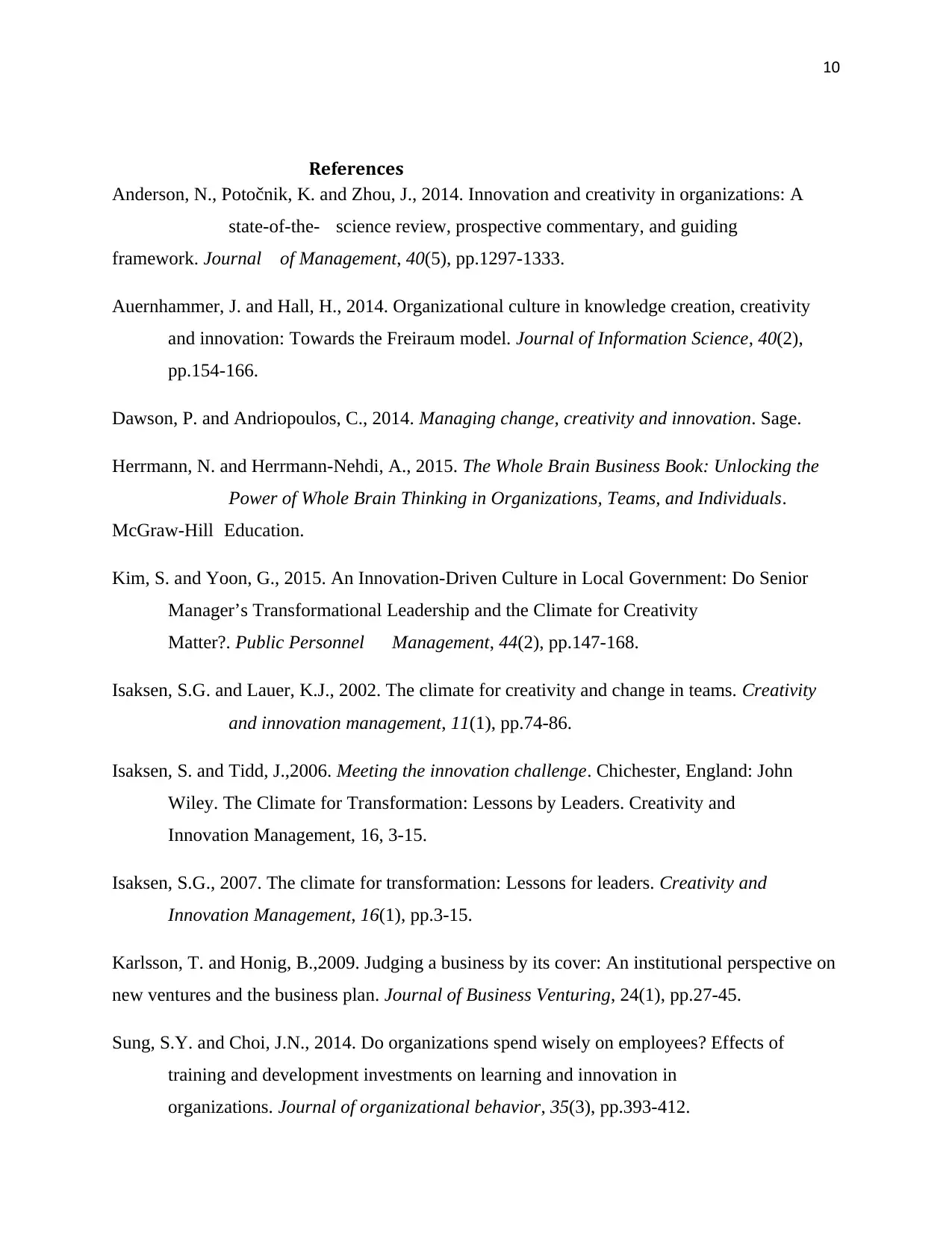
10
References
Anderson, N., Potočnik, K. and Zhou, J., 2014. Innovation and creativity in organizations: A
state-of-the- science review, prospective commentary, and guiding
framework. Journal of Management, 40(5), pp.1297-1333.
Auernhammer, J. and Hall, H., 2014. Organizational culture in knowledge creation, creativity
and innovation: Towards the Freiraum model. Journal of Information Science, 40(2),
pp.154-166.
Dawson, P. and Andriopoulos, C., 2014. Managing change, creativity and innovation. Sage.
Herrmann, N. and Herrmann-Nehdi, A., 2015. The Whole Brain Business Book: Unlocking the
Power of Whole Brain Thinking in Organizations, Teams, and Individuals.
McGraw-Hill Education.
Kim, S. and Yoon, G., 2015. An Innovation-Driven Culture in Local Government: Do Senior
Manager’s Transformational Leadership and the Climate for Creativity
Matter?. Public Personnel Management, 44(2), pp.147-168.
Isaksen, S.G. and Lauer, K.J., 2002. The climate for creativity and change in teams. Creativity
and innovation management, 11(1), pp.74-86.
Isaksen, S. and Tidd, J.,2006. Meeting the innovation challenge. Chichester, England: John
Wiley. The Climate for Transformation: Lessons by Leaders. Creativity and
Innovation Management, 16, 3-15.
Isaksen, S.G., 2007. The climate for transformation: Lessons for leaders. Creativity and
Innovation Management, 16(1), pp.3-15.
Karlsson, T. and Honig, B.,2009. Judging a business by its cover: An institutional perspective on
new ventures and the business plan. Journal of Business Venturing, 24(1), pp.27-45.
Sung, S.Y. and Choi, J.N., 2014. Do organizations spend wisely on employees? Effects of
training and development investments on learning and innovation in
organizations. Journal of organizational behavior, 35(3), pp.393-412.
References
Anderson, N., Potočnik, K. and Zhou, J., 2014. Innovation and creativity in organizations: A
state-of-the- science review, prospective commentary, and guiding
framework. Journal of Management, 40(5), pp.1297-1333.
Auernhammer, J. and Hall, H., 2014. Organizational culture in knowledge creation, creativity
and innovation: Towards the Freiraum model. Journal of Information Science, 40(2),
pp.154-166.
Dawson, P. and Andriopoulos, C., 2014. Managing change, creativity and innovation. Sage.
Herrmann, N. and Herrmann-Nehdi, A., 2015. The Whole Brain Business Book: Unlocking the
Power of Whole Brain Thinking in Organizations, Teams, and Individuals.
McGraw-Hill Education.
Kim, S. and Yoon, G., 2015. An Innovation-Driven Culture in Local Government: Do Senior
Manager’s Transformational Leadership and the Climate for Creativity
Matter?. Public Personnel Management, 44(2), pp.147-168.
Isaksen, S.G. and Lauer, K.J., 2002. The climate for creativity and change in teams. Creativity
and innovation management, 11(1), pp.74-86.
Isaksen, S. and Tidd, J.,2006. Meeting the innovation challenge. Chichester, England: John
Wiley. The Climate for Transformation: Lessons by Leaders. Creativity and
Innovation Management, 16, 3-15.
Isaksen, S.G., 2007. The climate for transformation: Lessons for leaders. Creativity and
Innovation Management, 16(1), pp.3-15.
Karlsson, T. and Honig, B.,2009. Judging a business by its cover: An institutional perspective on
new ventures and the business plan. Journal of Business Venturing, 24(1), pp.27-45.
Sung, S.Y. and Choi, J.N., 2014. Do organizations spend wisely on employees? Effects of
training and development investments on learning and innovation in
organizations. Journal of organizational behavior, 35(3), pp.393-412.
1 out of 10
Related Documents
Your All-in-One AI-Powered Toolkit for Academic Success.
+13062052269
info@desklib.com
Available 24*7 on WhatsApp / Email
![[object Object]](/_next/static/media/star-bottom.7253800d.svg)
Unlock your academic potential
Copyright © 2020–2025 A2Z Services. All Rights Reserved. Developed and managed by ZUCOL.





